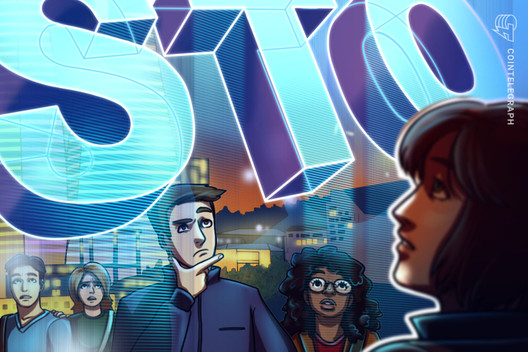The Death of the ICO: Has the US SEC Closed the Global Window on New Tokens?
The United States Securities and Exchange Commission’s vigor in pursuing initial coin offerings, or ICOs, has become a major boogeyman within the crypto community.
Most recently, the case against Telegram ended with that company abandoning its planned open network and Gram tokens, which raised $1.7 billion. The question before the crypto community is now: Have we witnessed the death of the ICO?
The answer is yes, in that, with all due fear of predictions, we will never see the likes of 2017’s ICO boom again. That vision of an ICO is indeed dead.
This is not the end for new tokens. But, until laws change comprehensively, the massive capital raise that leads to a token that trades freely seems like a thing of the past.
Bird’s-eye view of SEC registration
The SEC came out of two landmark laws passed at the height of the Great Depression. The commission has substantial power over the sale of securities — a broad category of investments that generally entail either stake in an entity or debt to it. They are distinct from commodities, which will be described later. One of the SEC’s most significant powers is seemingly simple: Anyone offering securities to the U.S. public must register that offering with the SEC.
SEC registration requires a company disclose a great deal of its financial information, as well as decision-making power to the public. Not surprisingly, many companies don’t want to. Not that long ago, the assumption was that SEC registration had nothing to do with crypto. That has changed in the past three years.
Since cryptocurrencies don’t fall more obviously into the rest of the potential definitions of securities, their classification depends on the much-contested term “investment contracts.” What exactly constitutes an investment contract is determined by the Howey Test, a critical result of the ruling in SEC v. W.J. Howey Co. (1946) that remains the basis of the definition of a security today:
“For purposes of the Securities Act, an investment contract (undefined by the Act) means a contract, transaction, or scheme whereby a person invests his money in a common enterprise and is led to expect profits solely from the efforts of the promoter or a third party.”
The point is that investment contracts entail an investor handing over their money to another entity and, depending on that entity’s work, to see profits. Commodities, on the other hand, derive their value from the market. Different laws govern their trade.
The assumption is that there is no entity that has an overwhelming control over a commodity like oil, so there is no way to register a responsible entity. Royal Dutch Shell, however, has to register with the SEC to sell stock in the U.S., meaning that critical information about their operations is publicly available to anyone, even non-investors.
The guiding principle is that if a firm is going to raise money from public trading, they have to be more transparent than you can reasonably expect of smaller enterprises. In exchange for that transparency, publicly traded companies get access to a lot more capital. Understandably, the SEC’s interest in crypto expanded along with the bottom lines that ICOs were generating.
Brief history of the SEC’s role in crypto: Early years
In the early years of the Bitcoin network, the SEC was slow to involve itself. It was an arcane region of the internet that remained a novelty. The SEC largely either considered it no threat to investors or didn’t know what to do with it.
The SEC’s first Bitcoin-linked prosecution was in 2013. The commission charged Trendon Shavers with running a ponzi scheme promising huge returns based on a unique BTC investment strategy that didn’t exist. At the same time, the regulator issued a general warning to investors against such schemes using virtual currencies.
Fraud that they are, Ponzi schemes fall to the SEC to prosecute because they entail false promises of work from a third party. Shavers’ scheme was not that new. The point of contention in the Shavers case was whether an investment received in Bitcoin could even be considered “money” per the Howey Test. The court found it could, setting a critical precedent.
A new era of SEC scrutiny after the DAO report
The issue of ICOs remained unsettled for years, however. The DAO’s 2016 meltdown during its ICO, in which users invested ETH in exchange for DAO tokens, changed things. The event, which also gave birth to the Ethereum Classic hard fork, also compelled the SEC to issue the DAO Report of July 25, 2017. This report confirmed that The report confirmed that the SEC would not prosecute Slock.it, the firm largely responsible for the DAO. But, crucially, it also determined that the DAO was indeed an unregistered securities offering and, next time, the SEC would not be so merciful.
“Anybody who had been touting [a new token] before the DAO report was ok,” said attorney John Berry, who left the SEC’s enforcement division in 2019.
Those ICOs that came before the DAO report benefited from some grandfathering in, remaining unscathed if they are demonstrably decentralized. Most regulators accept Bitcoin as a commodity, and if the current CFTC chairman gets his way, Ether seems set to get the same treatment, despite its ICO.
“No, Ethereum can’t happen again today, because the first part of the Ethereum story, the capital raise, was a security,” Philip Moustakis, a founding member of the Cyber Unit within the SEC’s enforcement division, explained to Cointelegraph.
Since the DAO report, the question has been how a new token can come into being that operates like Bitcoin or even Ether. Despite the anonymity of Satoshi Nakamoto, both of those networks owe their early years to core groups of developers who, were they to operate in the same fashion in 2020, might well face the wrath of the SEC.
On the flip side, Peter Van Valkenburgh of Coin Center told Cointelegraph that:
“I think you could still do Bitcoin. From the beginning of our advocacy in this space, we usually have at least one sentence saying, if you really want to build good decentralized networks, Satoshi was able to build one without a pre-sale.”
He did, however, agree that a project like Ethereum, which held an ICO, would be more problematic were that ICO to happen today.
As an example of a pre-DAO token that is still having trouble with the SEC, Ripple Labs remains busy denying that they were responsible for XRP, a token they retain an overwhelming stake in. One Ripple executive compared the relationship with Chevron’s to oil — a clear attempt to paint XRP as a commodity rather than an investment in Ripple Labs.
But what about the aftermath? Let’s examine some high-profile encounters between new tokens and the SEC.
Block.one and EOS — $4 billion netted relatively peacefully
An interesting case study is that of block.one and EOS. Block.one, a firm that produces open-source software, was the driving force behind the EOS ICO. Netting $4 billion in total, it remains the largest ever. In addition, it is an interesting case study both because the year-long ICO began just a month before the SEC issued the DAO report, and the firm included an advisory on the site for its ICO against U.S.-based investors participating.
The SEC went on to investigate the EOS ICO, but would end up settling with block.one for $24 million. Whether it was just timing with the DAO report, or that the EOS Tokens were non-transferrable after the purchase period, or the fact that the purchase agreement’s explicit prohibitions on investors from the U.S. or China, the SEC didn’t seem to think it had a strong case.
“The fact that the SEC settled for $24 million — I think that indicates that the SEC saw some risk in their position,” said John Berry. Relative to the capital raised during the ICO, $24 million is peanuts, the kind of expense that a company would gladly chalk up as an opportunity cost. However, it doesn’t provide any security to current projects. Block.one came away from the encounter relatively unscathed, but the SEC did not commit to a public reason.
“I would caution those in the industry against modeling their ICOs after Block.one’s,” said Philip Moustakis. “To me there’s no clear message to take away from Block.one. At best, we’re reading tea leaves.”
Moreover, the settlement with the SEC is not the end of block.one’s potential liability for securities law violations. Starting in April, multiple class action lawsuits alleging that block.one violated both federal and state securities law in their ICO. These are still in their early stages, but show that the firm is not entirely out of the woods.
In the same vein as EOS, the ICO for Tezos (XTZ) predated the DAO Report. At $200 million, it was, at the time, the largest in history. Though the SEC never filed any formal action against the firm, a class action representing U.S.-based investors in the project accused the Tezos Foundation and affiliate Dynamic Ledger Solutions of violations of securities laws. The class is currently finalizing a settlement for some $25 million. The same case brought to light that the SEC is investigating the project on the same charges, and the class-action settlement would not necessarily protect the foundation from further SEC pursuit.
The SAFT Framework to appease the SEC
Over the course of 2017, lawyers in the space worked to conceptualize a new framework, a “Simple Agreement for Future Tokens,” or SAFT. Several heavy hitters in the industry released a white paper in October. As the EOS project had done, the SAFT Framework conceptualized a distinction between the initial sale of rights to tokens and the distributions of the tokens themselves.
The first leg would be securities, sold only to “Accredited Investors” using the SEC’s Regulation D to exempt the firm from full registration as a publicly traded company — a step EOS had not taken. That money would go to a registered centralized entity, who could use it to build out the network on which the tokens would operate in a manner free of that central entity. The early accredited buyers would be able to sell their tokens to the general public, even in America, as freely as they can Bitcoin. In theory.
The SEC never formally endorsed the SAFT Framework. However, statements from Chairman Jay Clayton near the end of 2018 indicated support for the concept that virtual currencies can go from being securities to not being securities. In June of the same year, William Hinman, head of the SEC’s fintech office FinHub, made similar comments.
However, the SAFT framework has seen mixed results, and recent events suggest that the SEC is capricious when it comes to firms making the switch from initial funding round to token issuance.
Canadian messaging app Kik got in trouble for using a SAFT in an ICO in September 2017 and remains locked in a deathmatch with the SEC. However, part of their issue was that the app itself was failing, so its Kin token struck many as a lifeboat on a sinking ship rather than an earnest project. Kik had also already had issues with the SEC’s Canadian equivalent.
Often held up as the great success story of the SAFT era, Protocol Labs managed to raise $257 million in an ICO for Filecoin shortly after the DAO report. The firm touted its eagerness to comply with the SEC and decentralize so that Filecoin’s network can operate independently, as a mechanism to provide peer-to-peer file storage. Though by all accounts the SEC is content with Protocol Labs, the firm has yet to launch its network, the most recent estimate being for Q3.
The launch of a mainnet will be the critical test, as Telegram found out. Telegram, the most high-profile project to use the SAFT Framework, is also the most spectacular failure and will very possibly be the last.
Telegram and the failure of the SAFT framework
Last week, Telegram announced that it was backing out of its planned Telegram Open Network. As mentioned earlier, the ICO for TON’s native Gram tokens raised $1.7 billion before the SEC filed an emergency action stopping their distribution in October.
The Telegram case has been brief and heated. The firm tried to follow the SAFT Framework by registering its purchase agreements — NOT the Gram tokens — under a Reg. D exemption. This was effectively a promise to sell those contracts exclusively to accredited investors. The disagreement really starts here.
Per the SAFT Framework, Telegram was hoping that the SEC would accept that the Gram itself was not a security. For its part, Telegram agrees that they had made every effort to keep the SEC involved so as to avoid exactly this sort of action. The SEC’s counterargument was that the Grams were still securities, largely because Telegram had no luck convincing either the commission or the judge that the network, TON, was actually complete.
The state of TON is critical for the “third party” prong of the Howey Test. If the network is still dependent on Telegram’s development, the argument goes, the Gram tokens still constituted an investment in the company’s work.
The issue is that Telegram was verifiably working with regulators throughout the process. It’s spooky for potential future companies looking to raise capital to fund projects that a project with the technical and financial backing of TON wasn’t able to appease regulators and will have to give back a sum of money that puts Telegram itself in jeopardy.
“The Judge basically presumes there would be a crime before there was a crime and is therefore intervening in a way that sends a bad signal to other projects,” said Kristin Smith of the Blockchain Association, which wrote multiple amicus curiae briefs defending Telegram in the case. “From our perspective at the Blockchain Association, this is why we need to have an additional regulator and/or legislative solution that provides a legal pathway.”
What Telegram represents is the collapse of a project backed by the Pavel and Nikolai Durov, two brothers who had already launched two massive online platforms (in addition to Telegram, the Russian social media platform, VKontakte). Moreover, TON seemed well-intentioned and it was clearly well-funded, though Telegram has only offered to return some of the funds invested. The fact that the SEC stopped it in its tracks will be ominous to all future prospective issuers. It’s a new era, and the case is still in court.
In his letter announcing the end of Telegram’s involvement in TON, Pavel Durov concluded by wishing future projects luck:
“You are fighting the right battle. This battle may well be the most important battle of our generation. We hope that you succeed where we have failed.”
Right now, nobody is sure how to take up that mantle. In a fascinating development, TON’s open-source version launched shortly before Telegram withdrew its involvement. While Telegram may be hard-pressed to reimburse investors, the functioning of the independent network without Telegram could very well play to their advantage in the court case. The SEC’s argument presumes that the network is dependent on Telegram’s work as a third party. The commission might still maintain that the network was not functional enough to be considered independent as of its original launch date. But if TON works now without Telegram’s active involvement, that certainly strengthens their argument that they were building a project that would leave the confines of the Howey Test.
On the other hand, if the open-source network falls apart, it could prove the SEC’s argument that Grams were indeed investments into Telegram and needed to be treated as securities independent of the initial purchase agreements all along.
Is everything a security by default?
A critical question that still stands is what new projects would be immune to classification as securities.
Speaking with Cointelegraph back in October, U.S. Representative Warren Davidson (R-OH) commented wryly on the position that the SEC has put new projects in:
“They’re literally told if you want to launch a token, whatever you think you want to do with it, come check with the SEC first. […] And you can grovel. If you grovel well enough, then we’ll give you a no-action letter. You have hundreds of companies waiting on no-action letters. They’ve approved two. You can’t raise capital while you’re waiting for that.”
Philip Moustakis explained that the SAFT framework had underestimated the scrutiny that the SEC would apply to tokens the firms hoped to issue as non-securities:
“Just because there’s some distance in time between the sale of SAFT and the sale of a token doesn’t mean that the SEC isn’t going to consider that token separately as a security. […] All of what I just said is based on the model of ICOs from 2017, 2018, in which each token represents a share in the issuer, and that is the original sin that needs to be addressed.”
For their part, the SEC’s fintech wing, FinHub, declined to comment on whether it’s possible to hold an ICO within the US without assuming it classifies as a security and also declined to direct Cointelegraph to anyone internally willing to go on the record about recent actions, instead deferring to the same two no-action letters that Davidson referenced back in October — TurnKey Jet and Pocketful of Quarters.
Two utility tokens in closed circuits have passed the Howie Test as non-securities
Respectively from April and July of 2019, TurnKey Jet and Pocketful of Quarters are the only two to have made the cut of no-action recommendations to the commission.
In TurnKey Jet’s case, the commission noted that it is selling tokens so that buyers can buy plane tickets for the same price outside of bank hours — no expectation of profits, and no wallets outside of TurnKey’s system, so the tokens are fairly locked into their value of $1 and occupy a specific role of convenience for a single airline.
Similarly, Pocketful of Quarters operates a gaming platform that offered users unlimited access to tokens at fixed prices. Those tokens, however, had no usage outside of the dedicated platform Pocketful of Quarters had the platform built out without funds from the sale of tokens.
Neither of these ICOs presents any sort of functional cryptocurrency. Instead, they are relatively pedestrian tokens, solving issues of convenience within closed and fairly limited systems.
Utility tokens like these fit more cleanly into Jay Clayton’s analogy of the Broadway ticket that people can trade but which gives you access to just a single show. A classic cryptocurrency that people use as payment for services that do not derive directly from the issuer is a more threatening endeavor. Moreover, the SEC didn’t issue any formal feedback on the matter, so they can retract or reverse any tentative guidance to be derived from these no-action letters.
What about staying out of the U.S.?
One tricky element of digital assets is their ability to cross borders freely. The U.S. SEC plays a major role in global financial regulations due to the size of the country’s economy and investment market.
When it comes to cryptocurrencies, the SEC has claimed potential jurisdiction over any token that could make its way to U.S. investors — given the technological savvy of many in the crypto world, difficult to avoid. EOS, in fact, tried. Many of the people most interested in these investment opportunities are those most capable of operating via VPNs and other technology that fudges geographical origins.
Telegram, in its response to the court’s preliminary injunction barring distribution of Grams, argued that only $424.5 million of the $1.7 billion they had raised was from U.S. investors. They wanted to distribute the remaining Grams, even offering the safeguard of “configuring the TON digital wallet to preclude U.S.-based addresses.”
The court may have reasoned that this was too little, too late. They may also have been sceptical of Telegram’s claims, given that they never believed TON to be complete anyway.
Arguably the most famous example of regulators shutting down a nascent cryptocurrency was Libra, which Congress attacked directly, without the SEC needing to file anything. Much to the annoyance of the House of Representatives Financial Services Committee, Libra set up shop in Switzerland rather than the U.S. And despite the elaborate schema of the Libra Association — which sought to distribute responsibility for the authority through an international union of companies and away from U.S.-registered company Facebook — Congress seemed pretty well-equipped to put the clamp on the project by treating it as a Facebook project and bringing CEO Mark Zuckerberg in to testify. Despite recent updates to the white paper, many still want to label Libra a security.
Why not just register as security tokens?
Not surprisingly, Security Token Offerings, or STOs, have taken on a more visible role. Functioning as professed securities, they use technologies learned from crypto including blockchain to provide quicker, reliable global trading of assets that fall cleanly within the SEC’s basket of what constitutes a security.
Blockstack, for example, sold $23 million worth of its STX tokens after filing a Reg. A+ exemption, a process that reportedly cost the firm millions. No SAFT. STX are functional tokens and remain securities.
To all appearances, Blockstack’s approach seems to be working, in the sense that the SEC has not taken any action against the firm. However, registration as a security limits a token’s trading options.
Muneeb Ali, CEO of Blockstack, weighed in on the challenge STX faces.:
“Internationally in several jurisdictions, it is clearly treated as a utility token — it already trades on Binance, for example. And we got legal opinions from those jurisdictions because the regulations are different and currently there’s no U.S. exchange for us. But the fact that U.S. exchanges — either a regulated exchange needs to exist, no license has been given out from the SEC yet for such regulated ATSs [Alternative Trading Systems] or an exchange — or you achieve sufficient decentralization to the point that even in the U.S., it is clearly a utility and not a security.”
Blockstack’s clear aim is to continue decentralizing its token so that it metamorphizes out of the cocoon of security status. Unfortunately, there’s no clear template for doing so within the SEC’s current framework. This presents curious hypotheticals.
“Imagine if the company, say Blockstack, decided to dissolve, but the network continued to run, because it’s open-source,” Coin Center’s Peter Van Valkenburgh theorized on the current state of security tokens. “At that point it’s sort of ridiculous. Who is there to file disclosures?”
Many at the SEC are interested in such transitions. In 2018, William Hinman of the SEC’s FinHub commented:
“If the network on which the token or coin is to function is sufficiently decentralized — where purchasers would no longer reasonably expect a person or group to carry out essential managerial or entrepreneurial efforts — the assets may not represent an investment contract.”
Earlier this year, after the Telegram case had begun, SEC Commissioner Hester Peirce began championing a safe harbor for projects looking to decentralize, but the COVID-19 pandemic seems to have completely wiped that proposal off the commission’s radar for now.
Given, however, that the conversation surrounding COVID-19 response has shifted from emergency action to longer-term financial action, we may be about to witness new motions to encourage companies to build and seek capital. For example, the SEC recently loosened its crowdfunding requirements.
“After the last financial crisis, there was the JOBS Act,” said Kristin Smith, regarding Peirce’s safe harbor. “A couple of months from now, I think that’s going to be a very live and active conversation.”
The Death of the ICO?
Projects will continue to form, and if they don’t ask for money they don’t have to worry about this question. As Coin Center’s Peter Van Valkenburgh told Cointelegraph recently:
“Since the beginning of our advocacy in this space, we usually have at least one sentence saying, ‘if you really want to build good decentralized networks, Satoshi was able to build one without a pre-sale.’”
Projects looking for funding, however, are looking at a rough path ahead. Institutional financial players have been examining blockchain technology more intently for private usages, but we’re looking at a new era.
We’ll have to watch out for whether Blockstack can turn its STX into non-securities, or Filecoin can launch its network without an SEC run-in, or even what happens to Telegram and Libra. Without a major change in laws, it’s hard to envision a new major project coming about and transfiguring an ICO into an accepted public currency like Bitcoin, given regulatory hawkishness.
Though this isn’t the end of new crypto projects, the window of time when you could ask for funds to start a new coin and watch it leave your stable seems to be closed. But that’s not to say it won’t open again.









